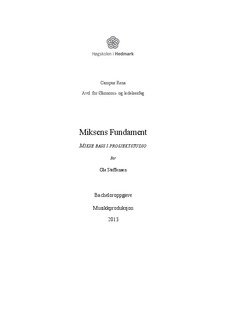| dc.contributor.author | Steffensen, Ole | |
| dc.date.accessioned | 2013-10-09T18:06:05Z | |
| dc.date.available | 2013-10-09T18:06:05Z | |
| dc.date.issued | 2013 | |
| dc.identifier.uri | http://hdl.handle.net/11250/133027 | |
| dc.description | Bacheloroppgave i musikkproduksjon, 2013 | no_NO |
| dc.description.abstract | Denne oppgaven gir svar på hvordan forskjellige teknikker fører til et godt fundament
i miksen. I dette tilfellet er fundamentet bass og basstromme. På veien mot et resultat
forklarer teksten forskjellige teknikker som er viktig for å oppnå det beste
fundamentet til å arbeide videre fra. Dette innebærer alt fra forståelse av lyd i
fysikken og akustikken, til målet med miksen og teknikker for å oppnå ønsket resultat.
Oppgavens overordnede mål er rettet mot å oppnå en bass som et godt fundament og
som er kompitabel med moderne lyttetrender. Dette betyr at bassen må være hørbar
på mindre lydkilder.
For å vise hvordan resultatene av teknikkene som former og endrer lydens egenskaper
i miksen følger det med gode illustrasjoner fortløpende i teksten. Dette er i tillegg til
det praktiske materiale som følger med på vedlagt CD. Disse sporene inneholder noen
eksempler av bassen, før og etter miksing, sammen med sluttmiksen av to
prosjektlåter. Oppgavens del om akustikkbehandling er brukt for å vise lyttemiljøet
resultatene er skapt i. Selv om målingsresultatene av rommet som ble arbeidet i viste
seg å ha visse dårlig akustiske egenskaper, gjenspeiles ikke nødvendigvis dette i
prosjektlåtene. Eksempler og fremgangsmåter som listes i teoridelen er godt
representert i resultatene.
I sum anses resultatene av teknikkene som er brukt relativt vellykket. Det var
problemer med rommets gjengivelse av lyd, men det ble skapt et resultat som som var
relativt godt. | no_NO |
| dc.description.abstract | Engelsk sammendrag (abstract):This study provides answers to how different mixing techniques lead to a good
foundation in the mix. In this case the foundation is the bass and the kick drum. On
the way towards the result, this study explains many of the techniques that are
essential for achieving the best foundation to build the rest of the mix on. This
involves understanding the objective of a mix and the many techniques that are
nesessary to achieve the desired results in the final mix. In addition this includes
recognizing the importance of physics of sound and its acoustical properties. The
main goal in question is geared towards obtaining a solid foundation, as well as
getting the mix compatible with modern listening trends. That means it needs to be
audible on small, portable audio devices.
To show the results of the techniques that shape and change a sound’s properties in
the mix, the study includes a good set of illustrating projections consecutively in the
text. In addition to this, the final mixes and some audio examples of the bass is
included on the enclosed CD. These examples are included to further show the results
- before and after.
The part regarding the acoustical treatment is presented to show the listening
environment that has been used to create the results. Altough the listening
environment did indeed have poor acoustic properties, it is not necessarily reflected in
the final results. The techniques and the various procedures listed in the theory part is
well represented trough the results of the final mix.
In sum the results are considered to be relatively successful. There were some
problems with the room’s sound reproduction, but all in all the results achieved were
realtively good. | eng |
| dc.language.iso | nob | no_NO |
| dc.subject | miksing | no_NO |
| dc.subject | musikk | no_NO |
| dc.subject | teknikker | no_NO |
| dc.subject | bass | no_NO |
| dc.subject | basstrommer | no_NO |
| dc.subject | lyd | no_NO |
| dc.subject | fundament | no_NO |
| dc.subject | lydkilder | no_NO |
| dc.title | Miksens fundament: mikse bass i prosjektstudio | no_NO |
| dc.title.alternative | The Foundation of the Mix: mixing bass in project studios. | en |
| dc.type | Bachelor thesis | no_NO |
| dc.subject.nsi | VDP::Humanities: 000::Musicology: 110 | no_NO |
| dc.source.pagenumber | 75 s. | no_NO |
